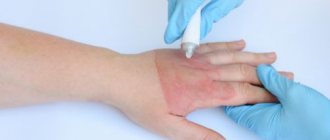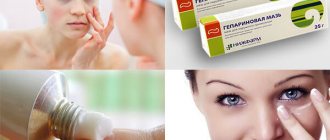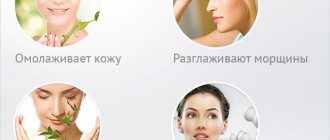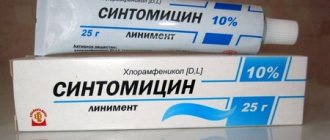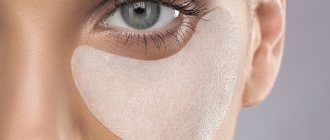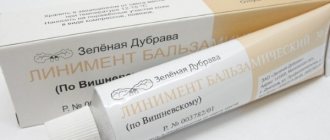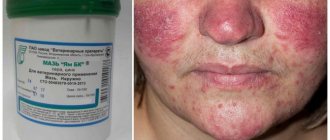- Composition and effect of Levomekol ointment
- Indications and contraindications for the use of Levomekol ointment
- Levomekol ointment - instructions for use
- Levomekol during pregnancy and children
- Levomekol for acne
- Levomekol for lips
- Levomekol ointment for boils
- Levomekol ointment for stitches
- Levomekol ointment in gynecology
- Treatment of wounds with Levomekol ointment
- Treatment of balanoposthitis with Levomekol ointment
- Analogs of Levomekol ointment
- Voskopran with Levomekol
Levomekol ointment, “the doctor’s favorite assistant,” has long established itself as an effective antibacterial agent that accelerates wound healing and helps restore normal structures of damaged skin.
| Being both an antibiotic and a reparative, Levomekol ointment has become one of the most popular ointments among surgeons in the treatment of deep ulcers, wounds of varying complexity and in restoring the integrity of the skin after suturing. |
Composition and effect of Levomekol ointment
The composition of 1.0 g of Levomekol ointment includes chloramphenicol 7.5 mg, methyluracil 40 mg, the base is polyethylene oxide 1500 and polyethylene oxide 400. Chloramphenicol is a broad-spectrum antibiotic, methyluracil is a drug that improves tissue trophism and stimulates the regeneration process. The combination of these two components makes wound healing successful and fast: thanks to Levomekol, the site of injury is protected from infections and at the same time supported by an effect that stimulates healing. Polyethylene oxide 1500 and polyethylene oxide 400 are auxiliary components; they facilitate uniform application of the ointment and help the active ingredients penetrate the tissues of the human body.
The main forms of release of the ointment are an aluminum tube (25g, 30g and 40g) or a dark glass jar (100g and 1000g each). The structure of the ointment is homogeneous and of medium thickness.
Levomekol, having anti-inflammatory, antibacterial and regenerating effects, belongs to the drugs with a combined spectrum of action.
Thanks to chloramphenicol, the ointment is effective in the fight against resistant gram-negative microorganisms, such as Pseudomonas aeruginosa and Escherichia coli, staphylococcus spp., etc. Frequent or extensive use of the ointment can cause microorganisms to become resistant to the drug, but this process happens relatively slowly.
Thanks to methyluracil, which easily penetrates the surface layers of the skin and accelerates the growth of new cells and the regeneration of damaged ones, the healing rate of wounds, cuts and postoperative sutures increases significantly. Moreover, methyluracil is an immune stimulant, which helps increase the production of interferon, a natural antiviral substance.
Excipients from Levomekol ointment help the active components penetrate deep into cell membranes without damaging them, creating an anti-inflammatory, decongestant and therapeutic effect.
The presence of pus or a large number of dead cells in the wound does not affect the effectiveness of Levomekol ointment.
Levomekol ointment has virtually no contraindications, with the exception of increased sensitivity to the components included in its composition, which in rare cases causes external allergic reactions. Moreover, there are no known cases of drug overdose, which indicates the harmlessness of its use among wide groups of people (including pregnant women, children). The ointment is indicated exclusively for external use, which determines the scope of its use - the skin.
Indications and contraindications for the use of Levomekol ointment
Frequent diseases and disorders for which Levomekol ointment is indicated are wounds with pus, wounds infected with mixed pathogenic microflora, and boils. The drug helps stop the inflammatory process, stop the infection zone, destroys dangerous microflora, and also relieves swelling at the site of the lesion.
The main indications for the use of Levomekol ointment are:
- Trophic ulcers.
- Boils.
- Purulent-inflammatory skin diseases.
- Second and third degree burns.
Prophylactic indications for the use of Levomekol:
- Seams.
- Wounds.
- Cuts.
- Calluses.
- Eczema.
- Bedsores.
The only reason for refusing to use Levomekol ointment may be increased sensitivity to the active substances included in the drug. It is worth noting that long-term use of the ointment can provoke an allergic skin reaction, but cases of allergies are scanty. Chronic diseases or other disorders are not a contraindication to use.
In what case should you consult a doctor and which one?
It is necessary to seek advice from a specialist in the following situations:
- Furunculosis - multiple ulcers of different localization and constantly recurring boils (pathology is diagnosed in patients with weakened immunity and poor personal hygiene).
- Ulcers in the area of the nasolabial triangle. There are vital organs and systems nearby, to which infection cannot be allowed under any circumstances.
A dermatologist diagnoses and treats skin diseases, and a surgeon provides surgical intervention.
Levomekol ointment - instructions for use
As already mentioned, Levomekol ointment is used exclusively externally. A thin layer of the drug is applied to the affected or damaged surface, after which the treated area of skin is tightly covered with sterile gauze or bandage rolled up in several layers (4-5).
Treatment of the wound surface is repeated several times a day for 5–10 days until the injury site is completely cleared of pus.
If the wound is deep and large, abundantly filled with pus or located in a body cavity, then the ointment is used in the form of a tampon (also made from a sterile bandage or gauze), which is inserted into the wound surface. Before the procedure, Levomekol is heated to 35 degrees, after which the tampon is generously soaked in ointment and slowly, consistently immersed in the wound until it is completely loosely filled.
If the wound has a shape that does not allow the installation of a tampon, the ointment is administered through a drainage tube using a medical catheter. The ointment slowly fills the wound through the tube, after which a fixing bandage is applied to it. The frequency of changing a bandage, tampon, or flap depends on the rate of its filling with purulent masses and necrotic particles of human tissue.
Napkins with Levomekol are replaced with new ones as they become saturated with pus and the accumulation of necrotic masses in them. If the wound is not deep, dressing is indicated once a day; in other cases, with severe infection and the presence of a large amount of pus, the dressings are changed 4-6 times a day. If the dressing was skipped, treatment is continued according to the previously planned schedule.
Levomekol is often used for minor disorders, such as purulent pimples, cuts and torn calluses. The scope of indications for the ointment also includes the treatment of bedsores in bedridden patients.
Levomekol ointment is often used for inflammatory processes in the auditory canal of the external ear. To do this, make a thin gauze tourniquet, soak it in ointment and place it shallowly in the ear for twelve hours. In the same way, Levomekol on gauze tourniquets is injected into the nasal passages and sinuses for sinusitis.
For purulent acne rashes, it is recommended to lubricate the affected area (at night) with a small layer of Levomekol ointment. After rupture of the pustule or mechanical removal of pus, the procedure should be repeated.
When using Levomekol externally, it is not recommended When applying the ointment, you must be careful and avoid the eye area and mucous membranes. Internal use of Levomekol is prohibited. If caution has not been observed, if the drug gets into the eyes or mucous membranes, rinse them with plenty of clean water, and in case of ingestion, rinse the stomach with water and activated charcoal.
Levomekol during pregnancy and children
Since the drug does not have a systemic effect and does not penetrate into the blood, it is allowed to be used by pregnant and nursing mothers.
Frequent cases of using Levomekol during breastfeeding or pregnancy are:
- treatment of sinusitis, otitis;
- treatment of minor cuts, abrasions, insect bites;
- treatment of minor burns;
- treatment of complications of ingrown toenails;
- treatment of complications after sloppy manicure;
- treatment of acne on the face or other parts of the body.
However, when in a position, it is worth remembering the increased dangers of self-medication. In case of serious injuries, it is better to seek qualified medical help.
Levomekol ointment can also be used in the treatment of children of different ages, including newborns and infants.
For children, Levomekol is indicated for:
- treatment of the umbilical wound;
- treatment of the cut site;
- treatment of mosquito bites, midges;
- treatment of pustules;
- treatment of vaccination and injection sites;
- treatment of scratches, abrasions, bruises.
Due to the high frequency of injuries, wounds and injuries among children of different ages, as well as due to the absence of contraindications for use and good tolerability, Levomekol ointment is recommended to be kept in your home medicine cabinet. However, it is worth remembering that frequent or prolonged use of the ointment can provoke the manifestation, more often than not, of a local allergic reaction on the skin in the form of redness, rash or itching; rarely, an allergy can manifest itself in the form of urticaria (the appearance of blisters similar in appearance to blisters after a nettle burn). The component that causes these symptoms is chloramphenicol.
What you need to know about treating boils
During the treatment of boils, you need to follow some rules in order for recovery to occur as early as possible and to prevent the spread of infection throughout the body. The patient must monitor the cleanliness of the skin and regularly perform hygiene procedures. High temperatures and overheating of the skin contribute to more active development of the disease. Therefore, you will have to forget about visiting steam rooms until you fully recover.
Before each skin treatment, you must thoroughly wash your hands with soap and treat them with an antiseptic. To prevent re-infection, it is necessary to change the pillowcases on your pillows daily until the wounds heal.
Provided that Levomekol is used correctly and all the rules of therapy with its use are followed, the boils will go away and will not even leave a mark on the skin. You should not use the ointment for a long time. If it does not help, you need to choose another remedy.
Levomekol for acne
Teenage acne or acne, as well as pimples caused by other reasons, can be effectively treated with Levomekol ointment.
The methods of using the ointment in this case are quite varied and depend on the severity of the rash.
In case of a profuse rash all over the face, the ointment should be applied to the entire surface of the face before going to bed for several hours, for two weeks.
If the cases of acne appearing are isolated, then the product is applied in a small layer, leaving for two to three hours, after which it is washed off. After a few days of use, the redness around the pimple disappears, and the site of inflammation is significantly reduced in size. Levomekol is indicated for treating acne not only on the face, but also on other parts of the body - neck, arms, chest, stomach, back, shoulders, etc.
In cases of severe acne, Levomekol ointment is recommended to be applied for a longer period of time, from 8 to 12 hours. After two weeks, the acne will either disappear or be ready for “mechanical” removal. Recurrence of acne during treatment with Levomekol is unlikely. In case of spot reappearance of acne, the ointment should be applied only to the places where they appear.
Clinical picture
As a boil forms in the nose, the patient’s condition may be aggravated by the following symptoms:
- increase in body temperature to subfebrile;
- headache;
- general weakness against the background of growing intoxication (especially during the transition to the carbuncle stage).
Most often, boils appear in the vestibule of the nose, since it is in this area that hair growth is observed.
Transition of boils into carbuncles
They can also occur at the tip of the nose and in the area of the nasolabial triangle. Externally, tissue hyperemia is noticeable. On palpation, severe pain is diagnosed. Further development of inflammation leads to swelling of this area, which covers the upper lip and cheek. A few days after the first signs appear, an abscess with a yellow-white stem forms.
Levomekol for lips
Some people use Levomekol ointment to treat herpes on the lips. But it is worth remembering that in this case, the use of the drug will be ineffective, since Levomekol has an antiseptic (antibacterial) rather than antiviral effect, and is not effective in the fight against herpes viruses.
However, at the stage of wound healing after a blister breaks, Levomekol ointment can speed up the process of tissue regeneration. But when applying the ointment to the lips, you should be careful to avoid getting it on the mucous membranes and swallowing it, since the ointment is intended exclusively for external use.
Levomekol ointment for boils
As with other purulent skin lesions, with boils, ointment is an excellent remedy that helps eliminate inflammation.
Before using Levomekol in the treatment of a boil, the affected area should be treated with alcohol or hydrogen peroxide, then a spot-apply ointment and cover it with gauze or a bandage, the compress should be changed 2-3 times a day, and a fresh bandage should be applied before going to bed.
After opening the abscess, the wound must be treated with hydrogen peroxide and Levomekol ointment applied again. The procedure must be repeated 2 times a day until the site of the boil has completely healed.
What to do when Levomekol does not help
After three days of regular use of the ointment, the condition of the skin should improve. But if this does not happen, then you should seek help from a specialist. Sometimes it may be necessary to surgically open the abscess in order to clear it of pus. The surgical operation to open the boil does not last long (only a few minutes) and after it is completed, Levomekol is used again. The wound cavity, cleared of pus, is filled with napkins soaked in ointment.
Levomekol ointment for stitches
Due to the high effectiveness of Levomekol ointment in healing wounds and cuts, it is often used in the treatment of postoperative sutures.
Frequent cases of using Levomekol ointment on sutures are sutures on the perineum in women after birth ruptures, as well as in case of their divergence. The scheme for using the ointment in this case is as follows:
- The perineum is washed with water and treated with a weak solution of furatsilin or potassium permanganate, better known as potassium permanganate.
- Dry the seam area with a soft cloth or towel; wait another 10-15 minutes for the skin to dry completely.
- Levomekol ointment is applied in a generous layer to a gauze flap and applied to the sutures.
- To secure the bandage and to prevent it from moving, wear underwear with a pad.
- The bandage is left at the suture site for two to six hours, then removed.
- The procedure is repeated until the seam is tightened.
In the case of other types of sutures on different parts of the body, the scheme for using Levomekol is identical, with the exception of the method of securing the flap with ointment; in other cases, a bandage or adhesive plaster is used. The frequency of changing the dressing is from two to four times a day; in case of suppuration of the wound or infection, the frequency of changing the dressing should be increased to 5 or more times.
Levomekol ointment in gynecology
Levomekol ointment is quite popular and is often used in gynecology for the following diseases:
- Cervical erosion.
- Inflammation of the ovaries, fallopian tubes.
- Dehiscence of the perineal sutures after childbirth.
- Bacterial vaginosis with inflammation.
- Vulvovaginitis with inflammation.
To treat all of the above diseases of the genital area of women, Levomekol is used in the form of tampons.
A cotton swab of dimensions 15 mm X 15 mm, and a height of 5 mm with Levomekol ointment is inserted into the vagina before bed, in the morning the tampon is removed and the usual hygiene of the external genitalia is carried out. The duration of treatment with ointment is from 10 to 15 days with daily repetition of the procedure.
It is worth remembering that inflammatory diseases of the genitourinary system in women can provoke both temporary and complete infertility, and therefore delaying their treatment is dangerous. Moreover, the prescription of a course of treatment and medications should be carried out under the supervision of a gynecologist.
Possible side effects
Side effects occur in patients when contraindications are ignored or the instructions for use are not followed. For more convenient study, side effects are listed in a table, and on the right it is indicated what needs to be done in each case.
| Body reaction | Actions |
| Allergy type urticaria | When the first signs appear, you must immediately stop the course of treatment and start taking an antihistamine (for example, Loratadine, Cetrin, Diazolin). Additionally, you need to consult a dermatologist in person for a consultation, as a result of which he will select another remedy for the treatment of boils. |
| Angioedema | Accompanied by shortness of breath, swelling of the skin of the face and neck. You need to call an ambulance immediately. Failure to act can be fatal. |
| Hyperemia, itching, burning | Observed when the duration and method of application are not observed. It is recommended to stop the course of treatment and consult a specialist. |
If you ignore the prohibition on using the drug during pregnancy or lactation, you can provoke undesirable consequences in relation to the health of the mother or baby. The ointment is used in pregnant and lactating women only after consultation with the attending physician and his or her prescription.
Treatment of wounds with Levomekol ointment
Thanks to the action of Levomekol ointment, its use is indicated in the treatment of various kinds of cuts, scratches, bites, abrasions and wounds. In case of a wound free from inflammation and pus, the ointment will help speed up healing and restoration of normal skin.
If the wound is filled with pus and has obvious signs of infection, then Levomekol, thanks to the presence of an antibiotic, will destroy pathogenic microflora, cleanse it of purulent and necrotic masses and speed up healing.
Before applying ointment to the wound, it should be treated with hydrogen peroxide or alcohol. The ointment is applied in a thin layer and, if necessary, covered with a bandage or gauze. The frequency of use of the ointment depends on the speed of wound healing.
In case of suppuration of the wound, before using Levomekol, the wound must be cleaned with a gauze pad with an antiseptic to remove superficial pus and dead tissue. After this, a bandage with ointment is applied and secured with a bandage or adhesive plaster; the bandage must be changed as it fills with wound particles (pus, necrotic tissue).
Reasons for the development of boils
Boils are purulent abscesses on the skin that are accompanied by inflammation. They come in several types: mixed, streptococcal, staphylococcal. Their appearance is caused by a corresponding infection. There is always a purulent core inside the boil. This abscess is characterized by the presence of a yellow spot in the center, discharge with blood and pus. With another type of inflammation, called a boil, a person may feel a fever and general malaise.
There are the following reasons for the development of furunculosis:
- lack of vitamins in the body;
- hairs ingrown into the skin;
- impaired metabolism;
- non-compliance with skin hygiene;
- increased production of sebum and sweat;
- long-term treatment with corticosteroid drugs;
- hypothermia;
- infectious, colds;
- disruption of the immune system;
- abrasions, scratches, wounds.
Treatment of balanoposthitis with Levomekol ointment
Balanoposthitis is an inflamed disease of the foreskin and glans penis of men. It can be caused by both bacteria and fungi, and can also serve as a manifestation of contact dermatitis.
If balanoposthitis is caused by bacterial microflora, then treating it with Levomekol ointment will be quick, successful and effective.
Treatment regimen for balanoposthitis with Levomekol:
- The penis is washed with a weak solution of furatsilin or potassium permanganate, better known as potassium permanganate.
- Dry with a soft cloth or towel, wait another 10-15 minutes for the skin to dry completely.
- Levomekol ointment is applied in a generous layer to the surface of the penis.
- The dressing is changed once or twice a day.
- After the main symptoms of the disease disappear, Levomekol should be applied to the penis once a day for another week.
How long to wait for positive dynamics and complete recovery
The drug helps get rid of the boil within 3-5 days. The duration of therapy depends on the stage of development of the abscess. A positive result in advanced cases (for example, with numerous furunculosis) is achieved only in combination with antibiotics and immunomodulators.
The following factors influence the treatment process and its duration:
- State of general and local immunity. Due to weakened resistance, the patient often experiences health problems, incl. and with skin. If there are no disturbances in the functioning of the immune system, the body will quickly cope with the infection. Recovery will occur within a week.
- Degree of disease. If 1-2 abscesses form, it will take no more than 5 days to get rid of unpleasant symptoms. With multiple abscesses, the patient is diagnosed with furunculosis. Its treatment with ointment is supplemented with other medications. The duration of treatment in this case takes about 2-3 weeks.
- The presence of systemic diseases - diabetes mellitus, vascular and blood diseases, HIV, autoimmune pathologies. A patient with one of these ailments is prescribed a longer treatment with ointment (and possibly other drugs), but under the strict supervision of a doctor, with preliminary passing of the necessary (in each specific case) tests.
You can find a complete list of methods for treating boils here.
Analogs of Levomekol ointment
Levomekol has synonymous drugs that contain the same active ingredients, chemical compounds and have the same range of indications.
Synonyms of Levomekol:
- Levomethyl ointment (applied to the affected areas of the skin in the form of aseptic dressings soaked in ointment, dressings are done every 2-3 days).
- Netran ointment (sterile gauze pads are impregnated with ointment, which loosely fill the wound; it can be administered through a catheter using a syringe; dressings are performed daily until the purulent-necrotic masses completely disappear).
analogue drugs are those drugs that contain different active substances, differ from each other in name, but are used to treat the same diseases .
Analogs of Levomekol ointment:
- Salicylic-zinc paste with chloramphenicol (for external use, applied to affected areas of the skin).
- Levosin ointment (dressings are carried out daily until the wound is completely cleansed of purulent, necrotic, dead tissue, it is possible to store the wound through a catheter).
- Lingesin ointment (used for the treatment of purulent-inflammatory diseases of the oral cavity and gums, rubbed into the gums after 1-2 days, after which 20-25 minutes later rinse the oral cavity with copious amounts of warm water).
- Protegentin ointment (used for the treatment of purulent-inflammatory diseases of the skin and soft tissues: boils, carbuncles, bursitis, burns, trophic ulcers of the lower leg, bedsores, purulent wounds in the first phase of the wound process).
- Streptonitol ointment (used for the treatment of purulent wounds of various origins: postoperative, after opening phlegmons and abscesses, etc., in phases of inflammation).
- Fastin 1 ointment (used for the treatment of burns, purulent wounds, pyoderma; externally, applied to sterile gauze pads and applied to the affected surface, the dressing is changed after 7–10 days).
- Fugentin drops (for instillation into the nasal passages and ears).
Voskopran with Levomekol
Voskopran is a wound-healing dressing impregnated with Levomekol ointment. Both of these tools effectively complement each other.
At the stage of an open wound, Voskopran does not stick to the site of the lesion, which makes it easier to change dressings, and at the stage of the beginning of healing, it adheres tightly to the skin, which provides protection from pathogenic microorganisms; at the end of healing, Voskopran easily moves away from the place where the wound was.
Indications for use of Voskopran with Levomekol:
- purulent wound surfaces;
- trophic ulcers;
- bedsores;
- diaper rash;
- thermal, chemical, and other burns of 1st – 3rd degree;
- frostbite;
- purulent and inflammatory skin lesions.

